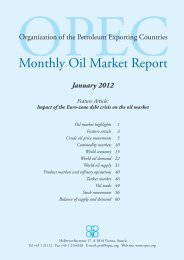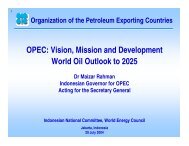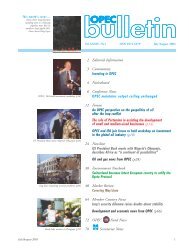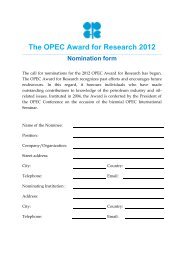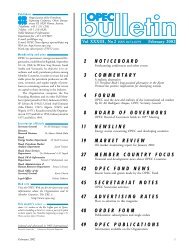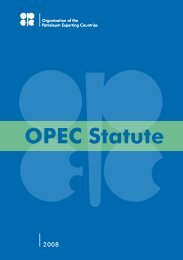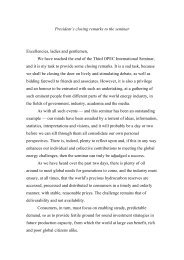Section One
Section One
Section One
Create successful ePaper yourself
Turn your PDF publications into a flip-book with our unique Google optimized e-Paper software.
ut ownership in South Asia and Africa will still only be around one car per 20 people in<br />
2035. The OPEC car ownership rate almost doubles, from 68 to 128 per 1,000.<br />
Commercial vehicles<br />
The Reference Case projection for commercial vehicles 39 is shown in Table 2.3.<br />
Total volumes in 2035 reach just over 440 million, increasing on average by 3.5%<br />
p.a., similar to the expected average rate of global economic activity. Once more,<br />
developing Asia is the key source of growth, accounting for 55% of the global rise<br />
(Figure 2.8).<br />
Oil use per vehicle<br />
Many factors will affect average oil use per vehicle. Wealth levels can have opposing effects,<br />
positively, as increases in wealth affect car purchase decisions, but also negatively<br />
Table 2.3<br />
The volume of commercial vehicles in the Reference Case millions<br />
Growth<br />
% p.a.<br />
2008 2020 2035 2008–2035<br />
North America 30 37 43 1.3<br />
Western Europe 38 49 69 2.3<br />
OECD Pacific 25 25 26 0.2<br />
OECD 93 112 138 1.5<br />
Latin America 15 25 38 3.6<br />
Middle East & Africa 10 19 37 5.1<br />
South Asia 8 25 64 8.1<br />
Southeast Asia 18 37 72 5.3<br />
China 14 27 50 4.9<br />
OPEC 10 17 28 3.7<br />
Developing countries 74 150 289 5.2<br />
Russia 6 6 7 0.7<br />
Other transition economies 3 5 7 2.6<br />
Transition economies 9 11 13 1.6<br />
World 176 273 441 3.5<br />
85<br />
Chapter<br />
2



